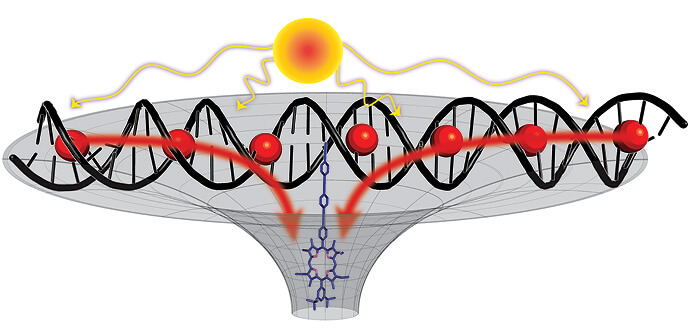Researchers from Kalmars University in Sweden have found an effective solution for absorbing sunlight to carry out an artificial photosynthesis process. Through a process of self-assembly of DNA molecules together with simple dye molecules, the researchers developed a system that is similar to the light absorption system that exists in nature.

Researchers from Kalmars University in Sweden have found an effective solution for absorbing sunlight to carry out an artificial photosynthesis process. Through a process of self-assembly of DNA molecules together with simple dye molecules, the researchers developed a system that is similar to the light absorption system that exists in nature.
Artificial photosynthesis is a fascinating research topic in the field of energy research. A significant part of the world's energy problems today could be solved if we succeeded in duplicating the ability of plants to convert solar energy coming from the sun into fuel. An amount of solar energy that is sufficient for all our energy needs for an entire year reaches the surface of the earth every hour.
A research team from Chalmers University in Sweden has brought about a nanotechnological breakthrough in the form of the first stage for the development of artificial systems that carry out photosynthesis. The team demonstrated that it is possible to use independently assembled DNA molecules as a scaffolding system to build artificial systems capable of absorbing and storing solar radiation. The results of the research were published in the scientific journal Journal of the American Chemical Society.
The scaffolding system in plants and algae consists of a considerable number of proteins in which the chlorophyll molecules are organized so that sunlight can be collected in the most efficient way. The entire system is extremely complex and cannot be fully reproduced artificially. "Everything is related to the question of which chemical bond breaks down," says one of the researchers. "If you use a DNA molecule instead of proteins to organize the light-receiving molecules, it is true that you cannot reach the same level of precision, but you can create a dynamic system that aggregates independently."
With a system that builds itself, the researchers began to approach the process that exists in nature. If one of the light-absorbing molecules breaks down, it can be replaced by a second molecule later. In this context, it is a self-repairing system, as opposed to a system obtained through normal synthetic organic chemistry.
In nature itself, the sun's rays reach a reaction center located inside the plants and algae when this energy is used to synthesize sugars and other energy-rich molecules. "We can transfer energy to the reaction center, but we still don't understand exactly how the various reactions take place there," says Bo Albinsson, professor of physical chemistry and lead author of the paper describing the results of the experiments. "This is actually the most challenging part of artificial photosynthesis systems. We demonstrated that the "antenna" needed to receive the light can be easily built. We have duplicated this part of the miracle of natural creation."
In this study, the scientists combine an artificial photosynthetic system with nanotechnology based on DNA. When building nanoparticles, DNA molecules have proven to be excellent building materials. This is in light of the fact that the DNA strands have the ability to bind to each other in a predetermined manner. As long as the correct organization instructions are provided in the first place, DNA strands in a test tube can weave around each other in almost any desired shape and structure.
"It is similar to an assembly in which the many different parts fit each other in a unique way," explains the researcher. "This is the reason why we can create a relatively complex structure "on paper" and then imagine how it will look in reality. As a matter of fact, we used these very properties of the DNA molecules to control the way in which the sun's rays can be absorbed."
The news about the studyה

One response
Kalmar University (not Kalmars, s is part of Swedish grammar, not part of the name of the university)